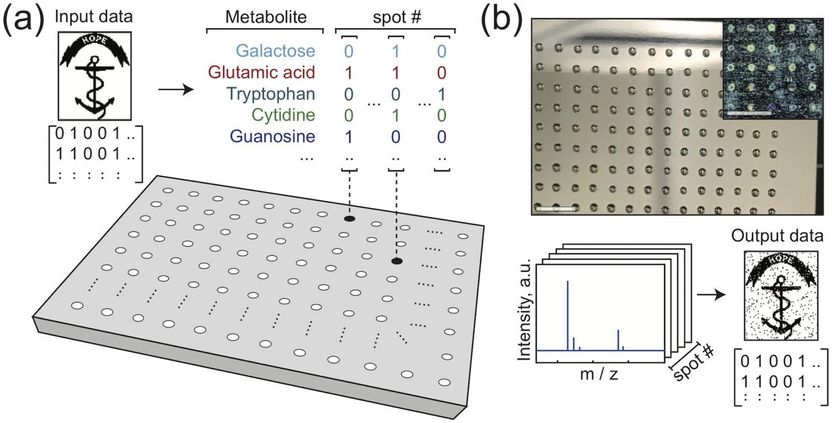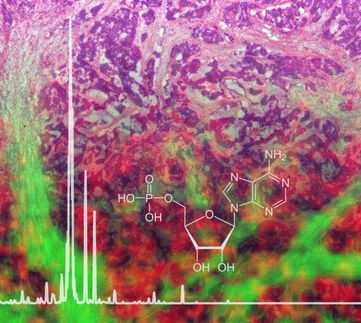Researchers save images not with a microchip, but with metabolites
Small molecules can encode data from an image and be read with over 98 percent accuracy
Advertisement
An anchor, an ibex and an Egyptian cat: all images that a research team from Brown University, led by Jacob Rosenstein, encoded and decoded from mixtures of small molecules called metabolites. They demonstrate the potential of this small-molecule information storage system in a new paper published July 3 in the open-access journal PLOS ONE.

Writing and reading data encoded in mixtures of metabolites. (a) Binary image data is mapped onto a set of metabolite mixtures, with each bit determining the presence/absence of one compound in one mixture. For example, a spot mapped to four bits with values [0 1 0 1] may contain the 2nd and 4th metabolite at that location. (b) Small volumes of the mixtures are spotted onto a steel plate and the solvent is evaporated (scale bars: 5 mm). This chemical dataset is analyzed by MALDI mass spectrometry (b, bottom). Using the observed mass spectrum peaks, decisions are made about which metabolites are present. These decisions are assembled from the array of spots to recover the original image. The image shown is the Rhode Island Hope Regiment Colors [28].
Kennedy et al., 2019
Microchips have become the standard way for people to store data, such as a document on a home computer or a snapshot on a phone. Recently, scientists have experimented with ways to encode information using biomolecules, such as DNA, by synthesizing an artificial genome. In this new study, the researchers show that they can encode information using a different type of biomolecule, metabolites. They used liquid-handling robots to write digital information by dotting mixtures of metabolites into a grid on a surface. The locations and identities of the metabolites, when read by an instrument called a mass spectrometer, reported out binary data. Using this method, they could encode the information from a picture and then decode it to redraw the image with 98 to 99.5 percent accuracy.
Mixtures of metabolites, called metabolomes, offer many advantages over genomes for recording information. Metabolites are smaller, more diverse, and have the potential to store information at greater density. This proof-of-principle study shows that small-molecule information storage can successfully encode more than 100,000 bits of digital images into synthetic metabolomes. They expect that with additional development, the amount and density of information that can be encoded will grow significantly.
Rosenstein adds: "We encoded several small digital images into mixtures of metabolites, and read back the data by chemically analyzing the mixtures. A molecular hard drive or a chemical computer might still seem like science fiction, but biology shows us it is possible. We wanted to show in a mathematically precise way how to write and read digital data using some of the small molecules that our bodies use every day."
Original publication
Other news from the department science
Most read news
More news from our other portals
See the theme worlds for related content
Topic World Mass Spectrometry
Mass spectrometry enables us to detect and identify molecules and reveal their structure. Whether in chemistry, biochemistry or forensics - mass spectrometry opens up unexpected insights into the composition of our world. Immerse yourself in the fascinating world of mass spectrometry!

Topic World Mass Spectrometry
Mass spectrometry enables us to detect and identify molecules and reveal their structure. Whether in chemistry, biochemistry or forensics - mass spectrometry opens up unexpected insights into the composition of our world. Immerse yourself in the fascinating world of mass spectrometry!
























































